Modelling Future Agricultural Mechanisation of Major Crops in China: An Assessment of Energy Demand, Land Use and Emissions
Abstract
1. Introduction
1.1. Emissions and Energy Use in Agriculture
Energy Inputs in Agricultural Crops
1.2. Agricultural Mechanisation
1.3. Agricultural-Based ESM and Relevance for Policy Makers
1.4. Study’s Aim
2. Materials and Methods
2.1. MUSE-Ag & LU Additions
2.1.1. Crop Selection
2.1.2. Crop Demand Projections
2.1.3. Mechanisation Levels
2.1.4. Crop Yields
2.1.5. Fertiliser Demand
2.1.6. Integrating CH4 and N2O Emissions
2.1.7. Techno-Economics of Mechanisation
2.1.8. Model’s Inputs/Outputs
2.2. Calibration and Validation
2.3. Scenarios
- Reference: To drive service demands, the SSP2 narrative, which describes a middle-of-the-road development for mitigation and adaptation [71], has been considered. The scenario considers a carbon price that is endogenously calculated by MUSE.
- Low development: In this scenario, the SSP3 narrative, which describes a fragmented world, failing to achieve sustainable development goals, with little efforts in reducing fossil fuel utilisation and negative environmental effects has been considered. In this scenario, higher population growth (resulting in higher food and feed demand), as well as increases in technological costs and fuel prices, and a reduction in yield growth rates have been varied considering a 20% deviation from the Reference scenario. Additionally, no carbon price is considered.
- High development: In this scenario, the SSP1 narrative, which describes a sustainable pathway, with constant efforts in reaching development goals and reducing dependency on fossil fuels mainly driven by rapid technological development, has been considered. In this scenario, lower population growth (resulting in lower food and feed demand), as well as reduction in technological costs and fuel prices, and increase in yields growth rates have been varied considering a 20% deviation from the Reference scenario. Apart from a carbon price for CO2 emissions, a specific tax has been imposed also on N2O and CH4. However, an imposed tax on these emissions needs to be weighted. Simulations have shown that a tax similar to the existing carbon level is too low, not only since N2O and CH4 are considerably more potent than CO2 but also due to the lower level of emissions; therefore, a low tax would be insignificant. On the other hand, applying a tax that reflects the global warming potential (e.g., N2O 298 times as strong as CO2) pushes technology levels back down to traditional agricultural practices and thus has an important impact on predicted land use and food security. At high GHG price rates, it is of interest for a farmer to revert to cheap, traditional technologies and use significantly more land to make up for the emissions costs. Therefore, compared to CO2 prices, a tax range between 0–300 times larger for N2O and 0–50 times larger for CH4 has been studied. After a sensitivity analysis, outputs suggest an optimal emission price of 10 times larger for CH4 and 25 times larger for N2O.
3. Results
3.1. Reference Scenario
3.1.1. Mechanisation Adoption and Investment
3.1.2. Energy/Fertiliser Demand and Related Emissions
3.1.3. Land Use
3.2. “Low” and “High” Development Scenarios
3.2.1. Mechanisation Adoption and Investment
3.2.2. Energy/Fertiliser Demand and Related Emissions
3.2.3. Land Use Change
4. Discussion
5. Conclusions
Author Contributions
Funding
Conflicts of Interest
Appendix A. Framework to Characterise Agricultural Processes Based on Qualitative and Quantitative Approaches
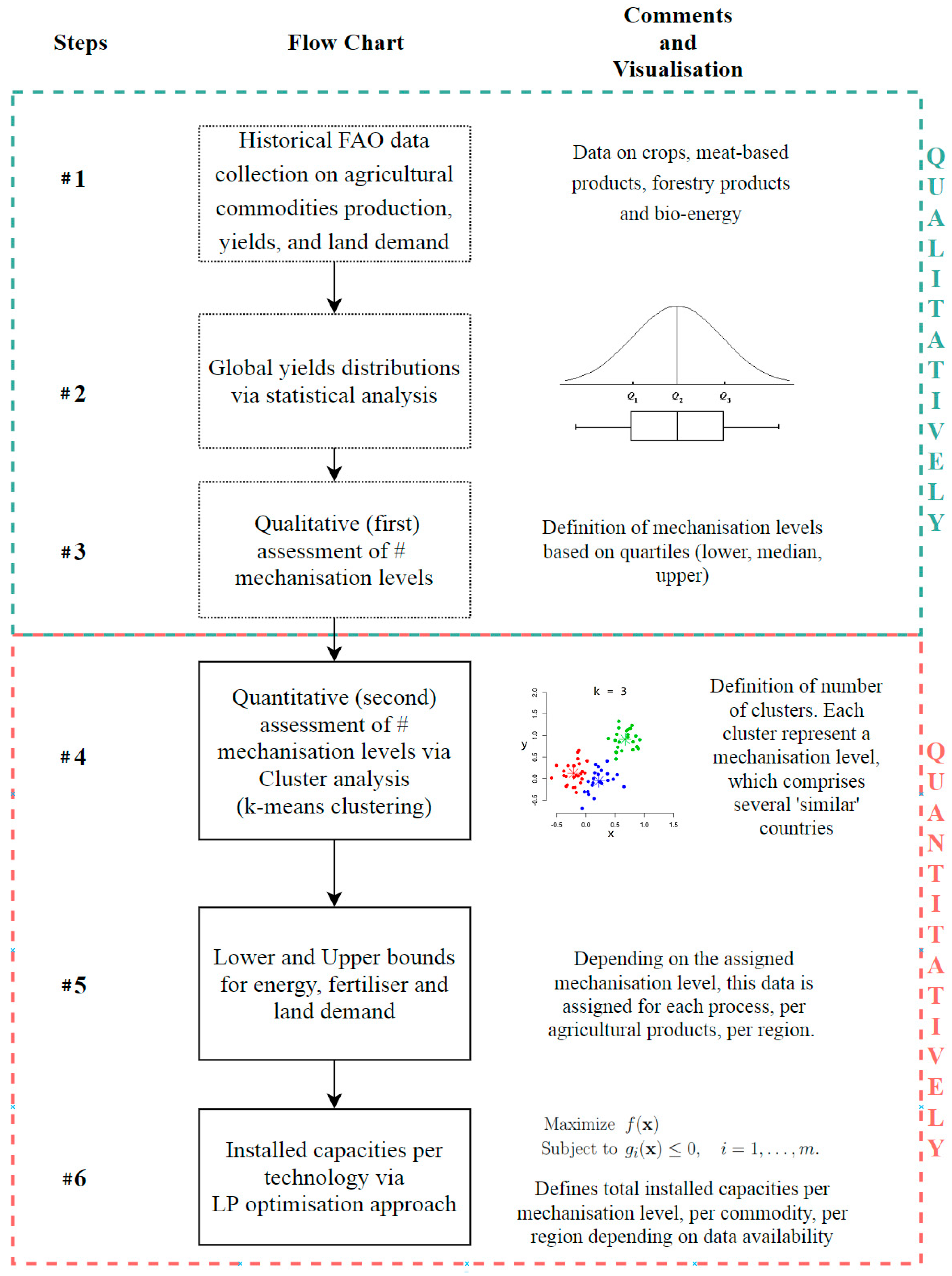
Appendix B. Mechanisation Installed Capacity Optimisation Model
| Type of Economy | Traditional | Transitional | Modern | Modern Renewable |
|---|---|---|---|---|
| θtrad | θtran | θmod | θmodern | |
| Least Developed (%GDPagr share > 0.16) | 50–70% | 10–20% | 10–20% | 1–2% |
| Emerging (0.02 < %GDPagr share < 0.16) | 10–20% | 50–70% | 10–20% | 3–5% |
| Developed (%GDPagr share < 0.02) | 10–20% | 10–20% | 50–70% | 5–10% |
Appendix B.1. Objective Function
Appendix B.1.1. Emissions Difference
Appendix B.1.2. Emissions of the Model
Appendix B.2. Constraints
Appendix B.2.1. Mass Balance
Appendix B.2.2. Service Demand
Appendix B.2.3. Mechanisation Level Share
Appendix B.2.4. Fuel Balance
Appendix B.2.5. Fuel Constraint
References
- Houghton, R.A.; Nassikas, A.A. Global and regional fluxes of carbon from land use and land cover change 1850–2015. Glob. Biogeochem. Cycles 2017, 31, 456–472. [Google Scholar] [CrossRef]
- De Cara, S.; Houze, M.; Jayet, P.A. Methane and nitrous oxide emissions from agriculture in the EU: A spatial assessment of sources and abatement costs. Environ. Resour. Econ. 2005, 32, 551–583. [Google Scholar] [CrossRef]
- Reay, D.S.; Davidson, E.A.; Smith, K.A.; Smith, P.; Melillo, J.M.; Dentener, F.; Crutzen, P.J. Global agriculture and nitrous oxide emissions. Nat. Clim. Chang. 2012, 2, 410–416. [Google Scholar] [CrossRef]
- IPCC. Climate change 2014: Synthesis report. In Contribution of Working Groups I, II and III to the 5th Assessment Report of the Intergovernmental Panel on Climate Change; IPCC: Geneva, Switzerland, 2014. [Google Scholar]
- Ray, D.K.; Mueller, N.D.; West, P.C.; Foley, J.A. Yield trends are insufficient to double global crop production by 2050. PLoS ONE 2013, 8, e66428. [Google Scholar] [CrossRef]
- FAO. Faostat. 2017. Available online: http://www.fao.org/faostat/en/data (accessed on 15 January 2019).
- Tilman, D.; Balzer, C.; Hill, J.; Befort, B.L. Global food demand and the sustainable intensification of agriculture. Proc. Natl. Acad. Sci. USA 2011, 108, 20260–20264. [Google Scholar] [CrossRef]
- Valin, H.; Sands, R.D.; van der Mensbrugghe, D.; Nelson, G.C.; Ahammad, H.; Blanc, E.; Bodirsky, B.; Fujimori, S.; Hasegawa, T.; Havlik, P.; et al. The future of food demand: Understanding differences in global economic models. Agric. Econ. 2014, 45, 51–67. [Google Scholar] [CrossRef]
- Bodirsky, B.L.; Rolinski, S.; Biewald, A.; Weindl, I.; Popp, A.; Lotze-Campen, H. Global food demand scenarios for the 21st century. PLoS ONE 2015, 10, e0139201. [Google Scholar] [CrossRef]
- Thornton, P.K. Livestock production: Recent trends, future prospects. Philos. Trans. R. Soc. Lond. B Biol. Sci. 2010, 365, 2853–2867. [Google Scholar] [CrossRef]
- He, G.; Zhao, Y.; Wang, L.; Jiang, S.; Zhu, Y. China’s food security challenge: Effects of food habit changes on requirements for arable land and water. J. Clean. Prod. 2019, 229, 739–750. [Google Scholar] [CrossRef]
- IEA. International Energy Agency Statistics. 2017. Available online: https://www.iea.org/statistics/ (accessed on 30 January 2019).
- FAO. World Agriculture: Towards 2015/2030 an FAO Perspective; Earthscan Publications Ltd.: London, UK, 2003. [Google Scholar]
- Heichel, G.H. Agricultural production and energy resources: Current farming practices depend on large expenditures of fossil fuels. How efficiently is this energy used, and will we be able to improve the return on investment in the future? Am. Sci. 1976, 64, 64–72. [Google Scholar]
- Walker, L.P. A method for modelling and evaluating integrated energy systems in agriculture. Energy Agric. 1984, 3, 1–27. [Google Scholar] [CrossRef]
- Uri, N.D. Motor gasoline and diesel fuel demands by agriculture in the United States. Appl. Energy 1989, 32, 133–154. [Google Scholar] [CrossRef]
- Uri, N.D.; Gill, M. Agricultural demands for natural gas and liquefied petroleum gas in the USA. Appl. Energy 1992, 41, 223–241. [Google Scholar] [CrossRef]
- Conforti, P.; Giampietro, M. Fossil energy use in agriculture: An international comparison. Agric. Ecosyst. Environ. 1997, 65, 231–243. [Google Scholar] [CrossRef]
- Xu, B.; Lin, B. Factors affecting CO2 emissions in china’s agriculture sector: Evidence from geographically weighted regression model. Energy Policy 2017, 104, 404–414. [Google Scholar] [CrossRef]
- Ozturk, I. The dynamic relationship between agricultural sustainability and food-energy-water poverty in a panel of selected sub-Saharan African countries. Energy Policy 2017, 107, 289–299. [Google Scholar] [CrossRef]
- Robaina-Alves, M.; Moutinho, V. Decomposition of energy-related GHG emissions in agriculture over 1995-2008 for European countries. Appl. Energy 2014, 114, 949–957. [Google Scholar] [CrossRef]
- Li, T.; Balezentis, T.; Makuteniene, D.; Streimikiene, D.; Krisciukaitiene, I. Energy-related CO2 emission in European Union agriculture: Driving forces and possibilities for reduction. Appl. Energy 2016, 180, 682–694. [Google Scholar] [CrossRef]
- Arnell, N.W.; Lowe, J.A.; Challinor, A.J. Global and regional impacts of climate change at different levels of global temperature increase. Clim. Chang. 2019, 155, 377–391. [Google Scholar] [CrossRef]
- Woods, J.; Williams, A.; Hughes, J.K.; Black, M.; Murphy, R. Energy and the food system. Philos. Trans. R. Soc. Lond. Ser. B 2010, 365, 2991–3006. [Google Scholar] [CrossRef]
- Camargo, G.G.T.; Ryan, M.R.; Richard, T.L. Energy use and greenhouse gas emissions from crop production using the farm energy analysis tool. BioScience 2013, 63, 263–273. [Google Scholar] [CrossRef]
- Pimentel, D. Energy inputs in food crop production in developing and developed nations. Energies 2009, 2, 1–24. [Google Scholar] [CrossRef]
- World-Bank. World Bank Open Data. 2017. Available online: https://data.worldbank.org/ (accessed on 30 January 2019).
- Riahi, K.; van Vuuren, D.P.; Kriegler, E.; Edmonds, J.; O’Neill, B.C.; Fujimori, S.; Bauer, N.; Calvin, K.; Dellink, R.; Fricko, O.; et al. The shared socioeconomic pathways and their energy, land use, and greenhouse gas emissions implications: An overview. Glob. Environ. Chang. 2017, 42, 153–168. [Google Scholar] [CrossRef]
- Djanibekov, U.; Gaur, V. Nexus of energy use, agricultural production, employment and incomes among rural households in Uttar Pradesh, India. Energy Policy 2018, 113, 439–453. [Google Scholar] [CrossRef]
- Schmitz, A.; Moss, C. Mechanized agriculture: Machine adoption, farm size, and labor displacement. AgBioForum 2015, 18, 278–296. [Google Scholar]
- Olesen, J.E. Socio-economic Impacts—Agricultural Systems. In North Sea Region Climate Change Assessment. Regional Climate Studies; Springer: Berlin/Heidelberg, Germany, 2016. [Google Scholar] [CrossRef]
- Ren, C.; Liu, S.; van Grinsven, H.; Reis, S.; Jin, S.; Liu, H.; Gu, B. The impact of farm size on agricultural sustainability. J. Clean. Prod. 2019, 220, 357–367. [Google Scholar] [CrossRef]
- Appel, F.; Ostermeyer-Wiethaup, A.; Balmann, A. Effects of the German renewable energy act on structural change in agriculture—The case of biogas. Util. Policy 2016, 41, 172–182. [Google Scholar] [CrossRef]
- Baruah, D.C.; Bora, G.C. Energy demand forecast for mechanized agriculture in rural India. Energy Policy 2008, 36, 2628–2636. [Google Scholar] [CrossRef]
- European Commission. Eurostat: Agri-Environmental Indicators. Available online: https://ec.europa.eu/eurostat/web/agriculture/agri-environmental-indicators (accessed on 2 November 2020).
- Ozkan, B.; Akcaoz, H.; Fert, C. Energy input-output analysis in Turkish agriculture. Renew. Energy 2004, 29, 39–51. [Google Scholar] [CrossRef]
- Singh, G. Estimation of a mechanisation index and its impact on production and economic factors—A case study in India. Biosyst. Eng. 2006, 93, 99–106. [Google Scholar] [CrossRef]
- Mileusnic, Z.I.; Petrovic, D.V.; Devic, M.S. Comparison of tillage systems according to fuel consumption. Energy 2010, 35, 221–228. [Google Scholar] [CrossRef]
- Dalgaard, T.; Halberg, N.; Porter, J.R. A model for fossil energy use in Danish agriculture used to compare organic and conventional farming. Agric. Ecosyst. Environ. 2001, 87, 51–65. [Google Scholar] [CrossRef]
- Nkakini, S.O.; Ayotamuno, M.J.; Ogaji, S.O.T.; Probert, S.D. Farm mechanization leading to more effective energy-utilizations for cassava and yam cultivations in rivers state, Nigeria. Appl. Energy 2006, 83, 1317–1325. [Google Scholar] [CrossRef]
- Alluvione, F.; Moretti, B.; Sacco, D.; Grignani, C. EUE (energy use efficiency) of cropping systems for a sustainable agriculture. Energy 2011, 36, 4468–4481. [Google Scholar] [CrossRef]
- Veiga, J.P.S.; Romanelli, T.L.; Gimenez, L.M.; Busato, P.; Milan, M. Energy embodiment in Brazilian agriculture: An overview of 23 crops. Sci. Agric. 2015, 72, 471–477. [Google Scholar] [CrossRef]
- Garcia Kerdan, I.; Giarola, S.; Hawkes, A. Implications of future natural gas demand on sugarcane production, land use change and related emissions in Brazil. J. Sustain. Dev. Energy Water Environ. Syst. 2020, 8, 304–327. [Google Scholar] [CrossRef]
- Garcia Kerdan, I.; Giarola, S.; Jalil-Vega, F.; Hawkes, A. Carbon sequestration potential from large-scale reforestation and sugarcane expansion on abandoned agricultural lands in Brazil. Polytechnica 2019, 2, 9–25. [Google Scholar] [CrossRef]
- De Oliveira, L.L.; Garcia Kerdan, I.; de Oliveira Ribeiro, C.; do Nascimento Oller, C.A.; Rego, E.E.; Giarola, S.; Hawkes, A. Modelling the technical potential of bioelectricity production under land use constraints: A multi-region Brazil case study. Renew. Sustain. Energy Rev. 2020, 123, 109765. [Google Scholar] [CrossRef]
- Yang, J.; Huang, Z.; Zhang, X.; Reardon, T. The rapid rise of cross-regional agricultural mechanization services in China. J. Agric. Econ. 2013, 95, 1245–1251. [Google Scholar] [CrossRef]
- Wise, M.; Calvin, K.; Kyle, P.; Luckow, P.; Edmonds, J. Economic and physical modeling of land use in GCAM 3.0 and an application to agricultural productivity, land, and terrestrial carbon. Clim. Chang. Econ. 2014, 5, 1450003. [Google Scholar] [CrossRef]
- FAO. “Energy-Smart” Food for People and Climate; Food and Agriculture Organization of the United Nations: Rome, Italy, 2011. [Google Scholar]
- Uri, N.D. Energy substitution in agriculture in the United States. Appl. Energy 1988, 31, 221–237. [Google Scholar] [CrossRef]
- Elobeid, A.; Tokgoz, S.; Dodder, R.; Johnson, T.; Kaplan, O.; Kurkalova, L.; Secchi, S. Integration of agricultural and energy system models for biofuel assessment. Environ. Model. Softw. 2013, 48, 1–16. [Google Scholar] [CrossRef]
- Miljkovic, D.; Ripplinger, D.; Shaik, S. Impact of biofuel policies on the use of land and energy in U.S. agriculture. J. Policy Model. 2016, 38, 1089–1098. [Google Scholar] [CrossRef]
- Rochedo, P. Development of a Global Integrated Energy Model to Evaluate the Brazilian Role in Climate Change Mitigation Scenarios. Ph.D. Thesis, Federal University of Rio de Janeiro, Rio de Janeiro, Brazil, 2016. [Google Scholar]
- Al-Mansour, F.; Jejcic, V. A model calculation of the carbon footprint of agricultural products: The case of Slovenia. Energy 2017, 136, 7–15. [Google Scholar] [CrossRef]
- Daioglou, V.; Doelman, J.; Wicke, B.; Faaij, A.; van Vuuren, D.P. Integrated assessment of biomass supply and demand in climate change mitigation scenarios. Glob. Environ. Chang. 2019, 54, 88–101. [Google Scholar] [CrossRef]
- Wu, W.; Hasegawa, T.; Ohashi, H.; Hanasaki, N.; Liu, J.; Matsui, T.; Fujimori, S.; Masui, T.; Takahashi, K. Global advanced bioenergy potential under environmental protection policies and societal transformation measures. GCB Bioenergy 2019, 11, 1041–1055. [Google Scholar] [CrossRef]
- Li, M.; Fu, Q.; Singh, V.P.; Liu, D.; Li, T. Stochastic multi-objective modeling for optimization of water-food-energy nexus of irrigated agriculture. Adv. Water Resour. 2019, 127, 209–224. [Google Scholar] [CrossRef]
- Elkadeem, M.R.; Wang, S.; Sharshir, S.W.; Atia, E.G. Feasibility analysis and techno-economic design of grid-isolated hybrid renewable energy system for electrification of agriculture and irrigation area: A case study in Dongola, Sudan. Energy Convers. Manag. 2019, 196, 1453–1478. [Google Scholar] [CrossRef]
- Jones, J.W.; Antle, J.M.; Basso, B.; Boote, K.J.; Conant, R.T.; Foster, I.; Godfray, H.C.J.; Herrero, M.; Howitt, R.E.; Janssen, S.; et al. Brief history of agricultural systems modelling. Agric. Syst. 2017, 155, 240–254. [Google Scholar] [CrossRef]
- Garcia Kerdan, I.; Giarola, S.; Hawkes, A. A novel energy systems model to explore the role of land use and reforestation in achieving carbon mitigation targets: A Brazil case study. J. Clean. Prod. 2019, 232, 796–821. [Google Scholar] [CrossRef]
- Paris Reinforce. The ModUlar Energy System Simulation Environment (MUSE). Available online: http://paris-reinforce.epu.ntua.gr/detailed_model_doc/muse (accessed on 9 December 2020).
- USDA. USDA Food Composition Databases. 2017. Available online: https://www.ers.usda.gov/data-products/commodity-costs-and-returns/ (accessed on 15 February 2019).
- Pradhan, P.; Lüdeke, M.; Reusser, D.; Kropp, J. Embodied crop calories in animal products. Environ. Res. Lett. 2013, 8, 044044. [Google Scholar] [CrossRef]
- Giarola, S.; Budinis, S.; Sachs, J.A.; Hawkes, A. Long-Term Decarbonisation Scenarios in the Industrial Sector, International Energy Workshop. 2017. Available online: http://events.pnnl.gov/images/IEW%202017/IEW2017_abstracts/Longterm%20decarbonisation%20scenarios%20in%20the%20industrial.pdf (accessed on 15 February 2019).
- Shahzad, S.J.H.; Hernandez, J.A.; Al-Yahyaee, K.H.; Jammazi, R. Asymmetric risk spillovers between oil and agricultural commodities. Energy Policy 2018, 118, 182–198. [Google Scholar] [CrossRef]
- Van Ruijven, B.J.; van Vuuren, D.P.; Boskaljon, W.; Neelis, M.L.; Saygin, D.; Patel, M.K. Long-term model-based projections of energy use and CO2 emissions from the global steel and cement industries. Resour. Conserv. Recycl. 2016, 112, 15–36. [Google Scholar] [CrossRef]
- Hartigan, J.A.; Wong, M.A. Algorithm AS 136: A K-Means Clustering Algorithm. J. R. Stat. Soc. C Appl. 1979, 28, 100–108. [Google Scholar] [CrossRef]
- Rousseeuw, P.J. Silhouettes: A graphical aid to the interpretation and validation of cluster analysis. J. Comput. Appl. Math. 1987, 20, 53–65. [Google Scholar] [CrossRef]
- Calabi-Floody, M.; Medina, J.; Rumpel, C.; Condron, L.M.; Hernandez, M.; Dumont, M.; de la Luz Mora, M. Smart Fertilizers as a Strategy for Sustainable Agriculture. Adv. Agron. 2018, 147, 119–157. [Google Scholar] [CrossRef]
- IPCC. 2006 IPCC Guidelines for National Greenhouse Gas Inventories; UNEP: Nairobi, Kenya, 2006. [Google Scholar]
- GAMS. General Algebraic Modeling System (Gams) Release 24.2.1. 2013. Available online: https://www.gams.com/ (accessed on 15 February 2019).
- Fricko, O.; Havlik, P.; Rogelj, J.; Klimont, Z.; Gusti, M.; Johnson, N.; Kolp, P.; Strubegger, M.; Valin, H.; Amann, M.; et al. The marker quantification of the shared socioeconomic pathway 2: A middle-of-the-road scenario for the 21st century. Glob. Environ. Chang. 2017, 42, 251–267. [Google Scholar] [CrossRef]
- IEA. Energy Technology Perspectives 2017: Catalysing Energy Technology Transformations; OECD/IEA: Paris, France, 2017. [Google Scholar]
- EIA. US Energy Information and Administration—Annual Energy Outlook 2017. 2017. Available online: https://www.eia.gov/outlooks/aeo/ (accessed on 15 February 2019).
- EMF. Energy Modelling Forum—EMF 27: Global Model Comparison Exercise. 2017. Available online: https://emf.stanford.edu/projects/emf-27-global-model-comparison-exercise (accessed on 3 March 2019).
- Xu, Y.J.; Li, G.X.; Sun, Z.Y. Development of biodiesel industry in China: Upon the terms of production and consumption. Renew. Sustain. Energy Rev. 2016, 54, 318–330. [Google Scholar] [CrossRef]
- Safdar, M.T.; van Gevelt, T. Catching Up with the ‘Core’: The Nature of the Agricultural Machinery Sector and Challenges for Chinese Manufacturers. J. Dev. Stud. 2020, 56, 1349–1366. [Google Scholar] [CrossRef]
- Huang, J.; Otsuka, K.; Rozelle, S. The Role of Agriculture in China’s Development: Past Failures, Present Successes, and Future Challenges; Stanford University: Stanford, CA, USA, 2007. [Google Scholar]
- OECD. Review of Agricultural Policies—China. Available online: https://www.oecd.org/china/oecdreviewofagriculturalpolicies-china.htm (accessed on 9 December 2020).
- Sibayan, E.B.; Samoy-Pascual, K.; Grospe, F.S.; Casil, M.E.D.; Tokida, T.; Padre, A.T.; Minamikawa, K. Effects of alternate wetting and drying technique on greenhouse gas emissions from irrigated rice paddy in central Luzon, Philippines. J. Soil Sci. Plant Nutr. 2017, 64, 39–46. [Google Scholar] [CrossRef]
- Erda, L.; Yue, L.; Hongmin, D. Potential GHG mitigation options for agriculture in China. Appl. Energy 1997, 56, 423–432. [Google Scholar] [CrossRef]
- Cisternas, I.; Velásquez, I.; Caro, A.; Rodríguez, A. Systematic literature review of implementations of precision agriculture. Comput. Electron. Agric. 2020, 176, 105626. [Google Scholar] [CrossRef]
- Stafford, J. Implementing Precision Agriculture in the 21st Century. J. Agric. Eng. Res. 2000, 76, 267–275. [Google Scholar] [CrossRef]
- FAO. Annex 3: Agricultural Policy and Food Security in China. Available online: http://www.fao.org/3/ab981e/ab981e0c.htm#bm12.3.7 (accessed on 9 December 2020).
- IRENA. Agriculture and Environment in EU-15—The IRENA Indicator Report; European Environment Agency: Copenhagen, Denmark, 2005. [Google Scholar]
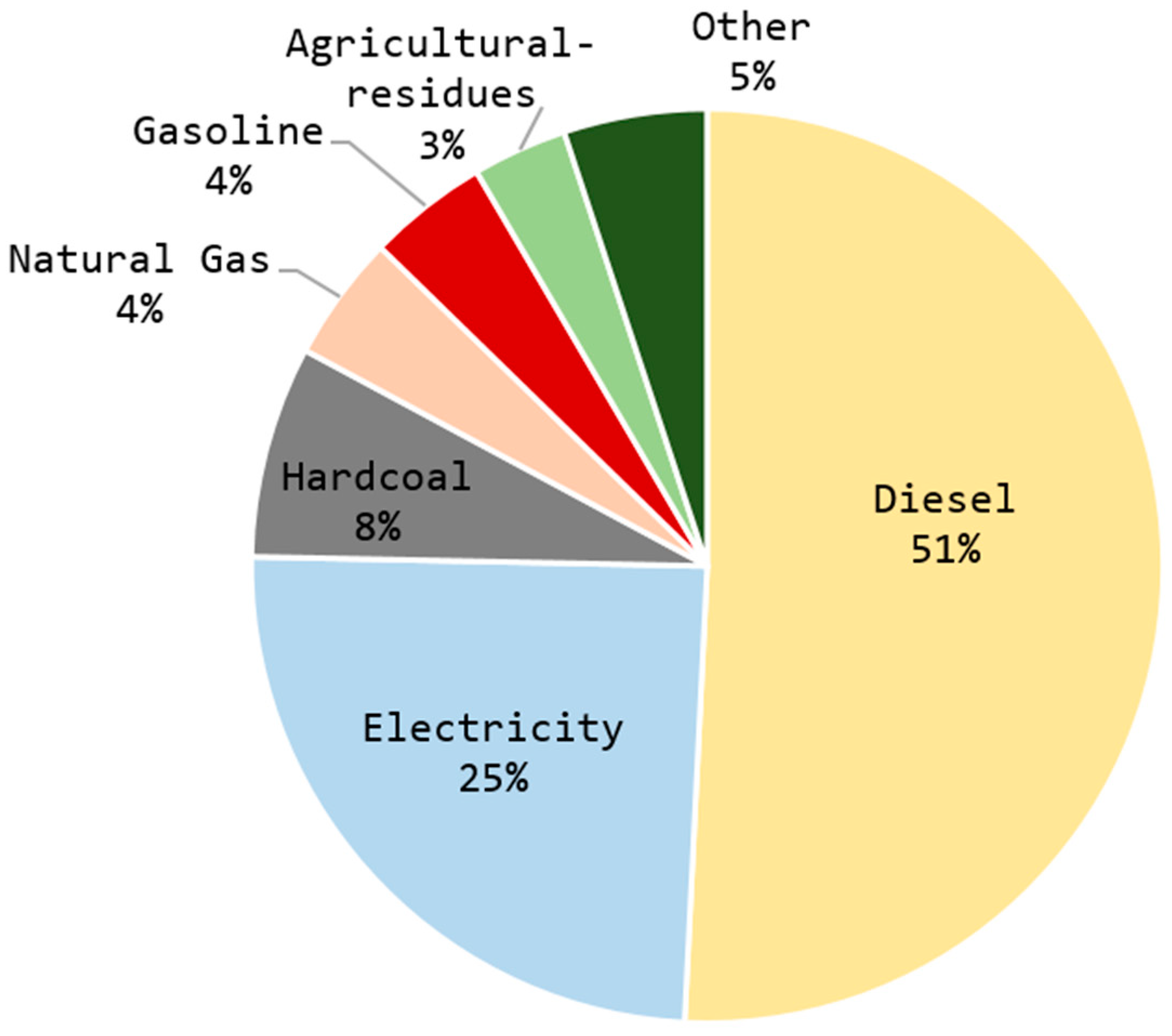
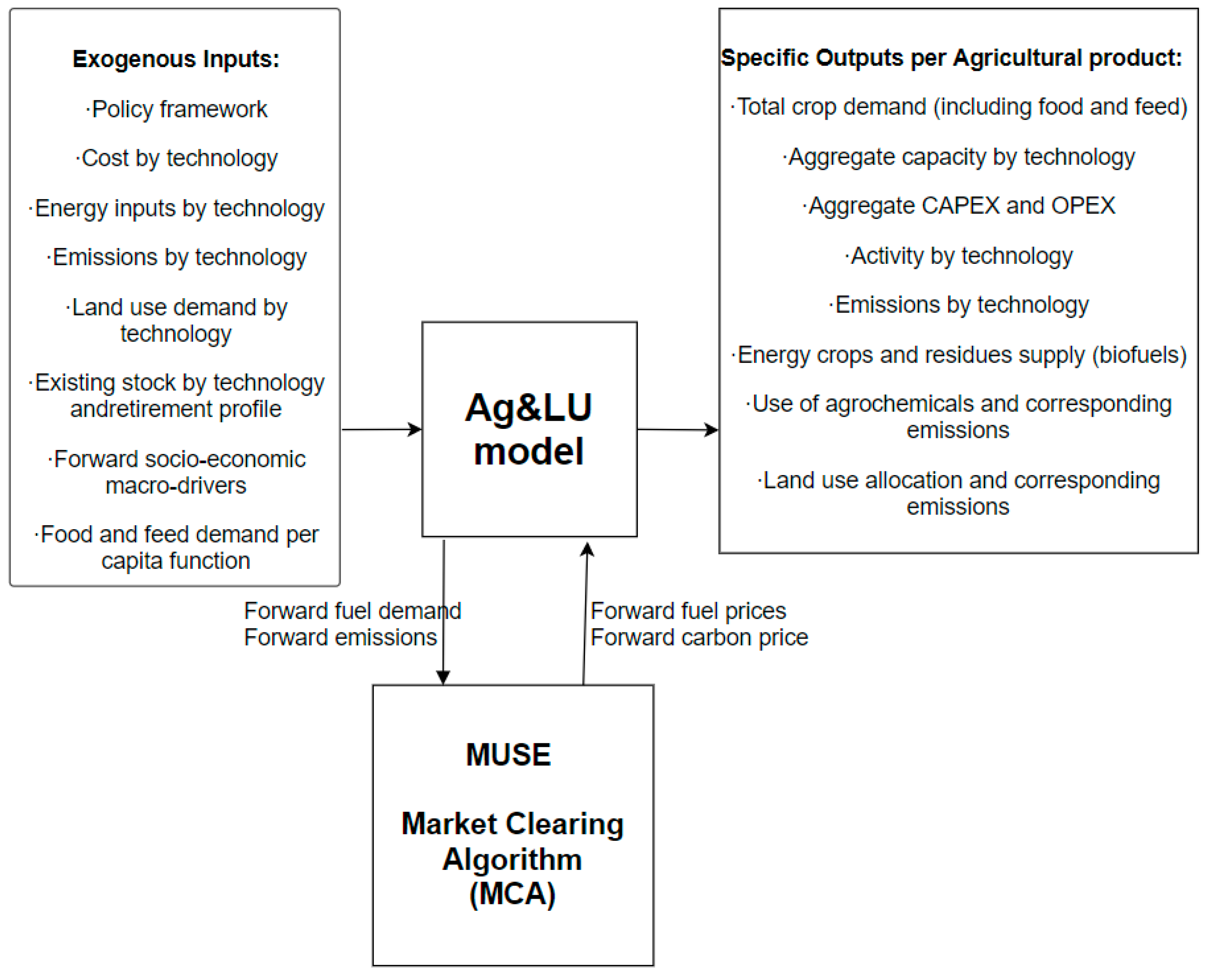
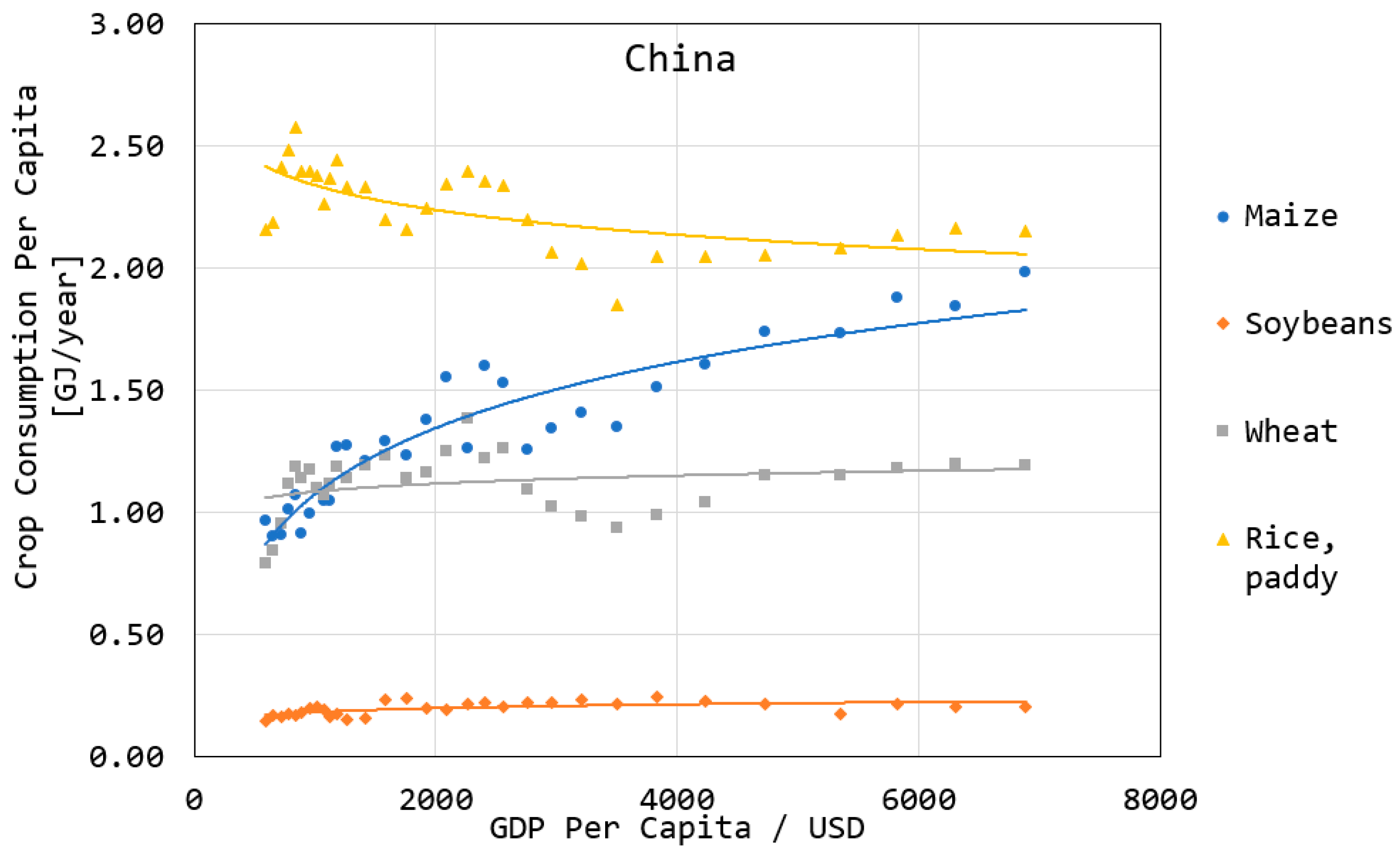
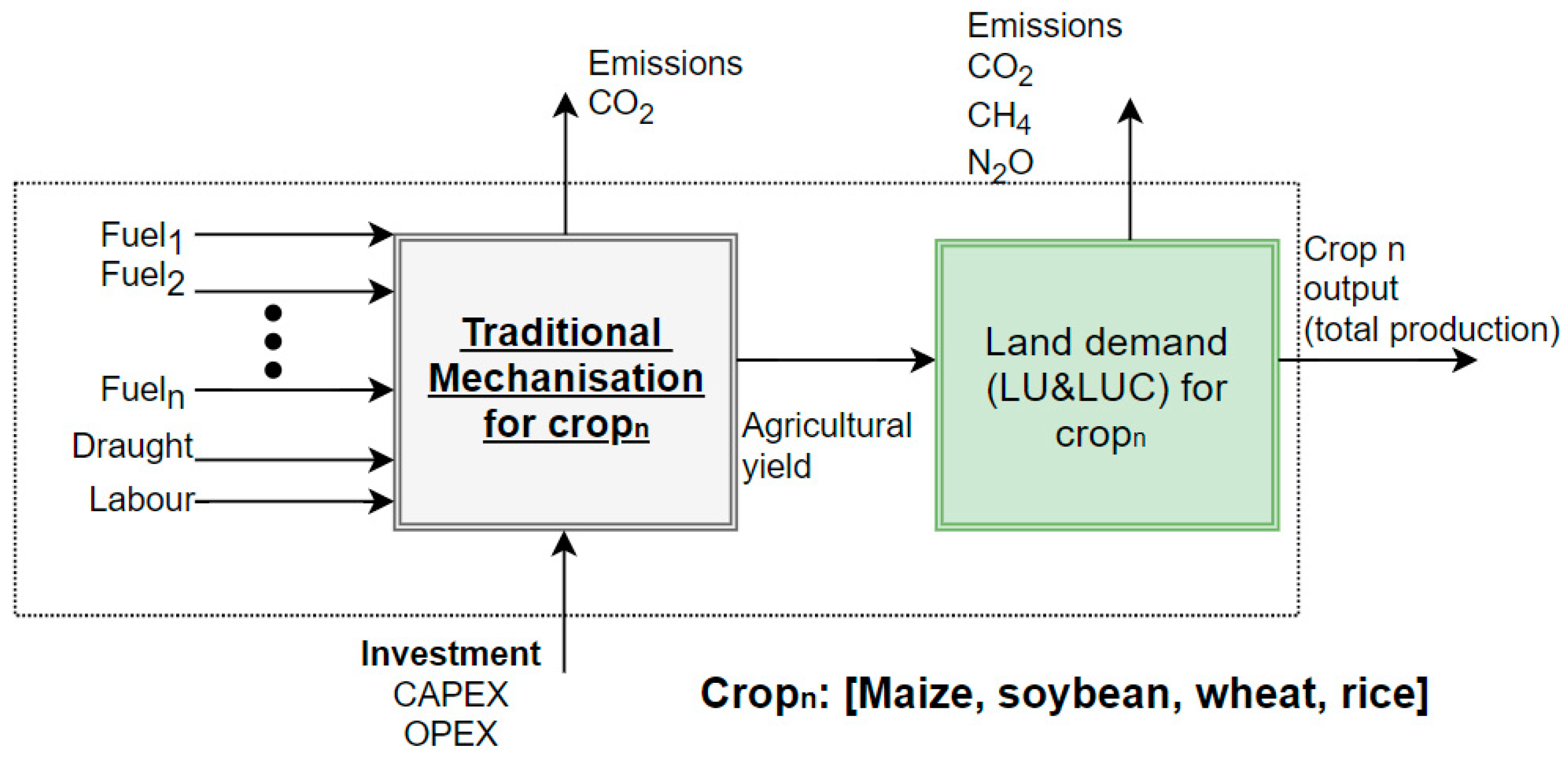
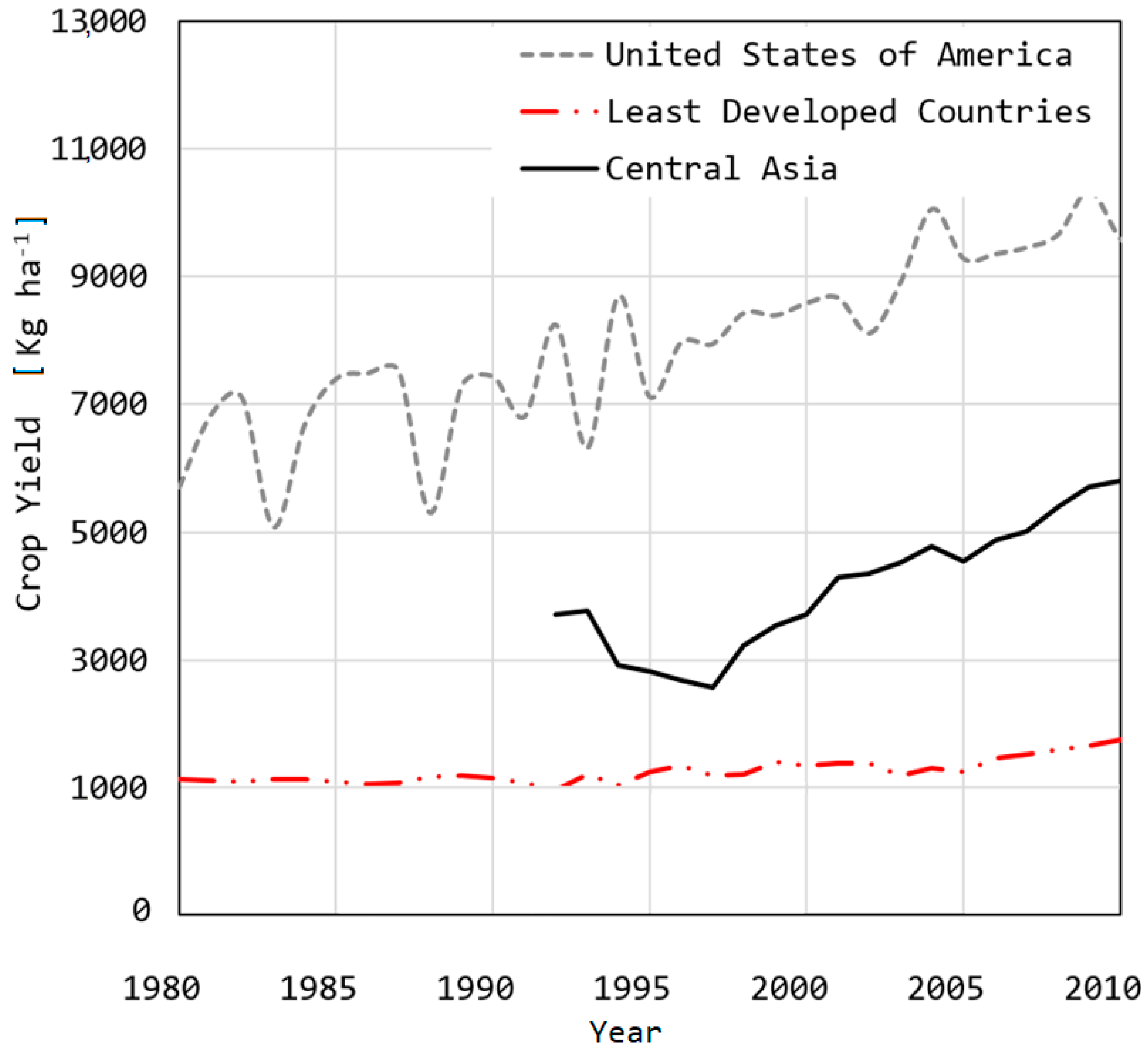
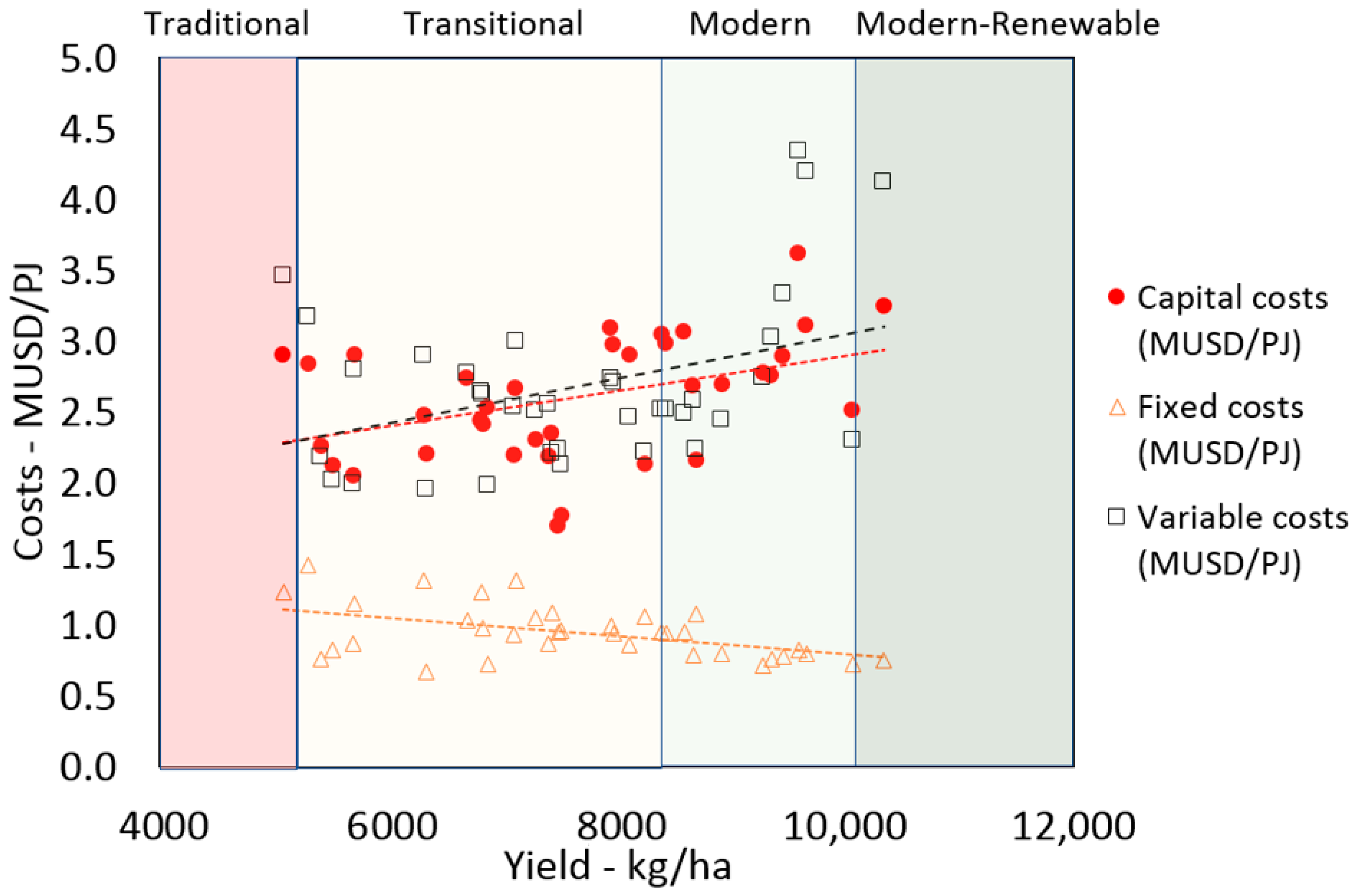
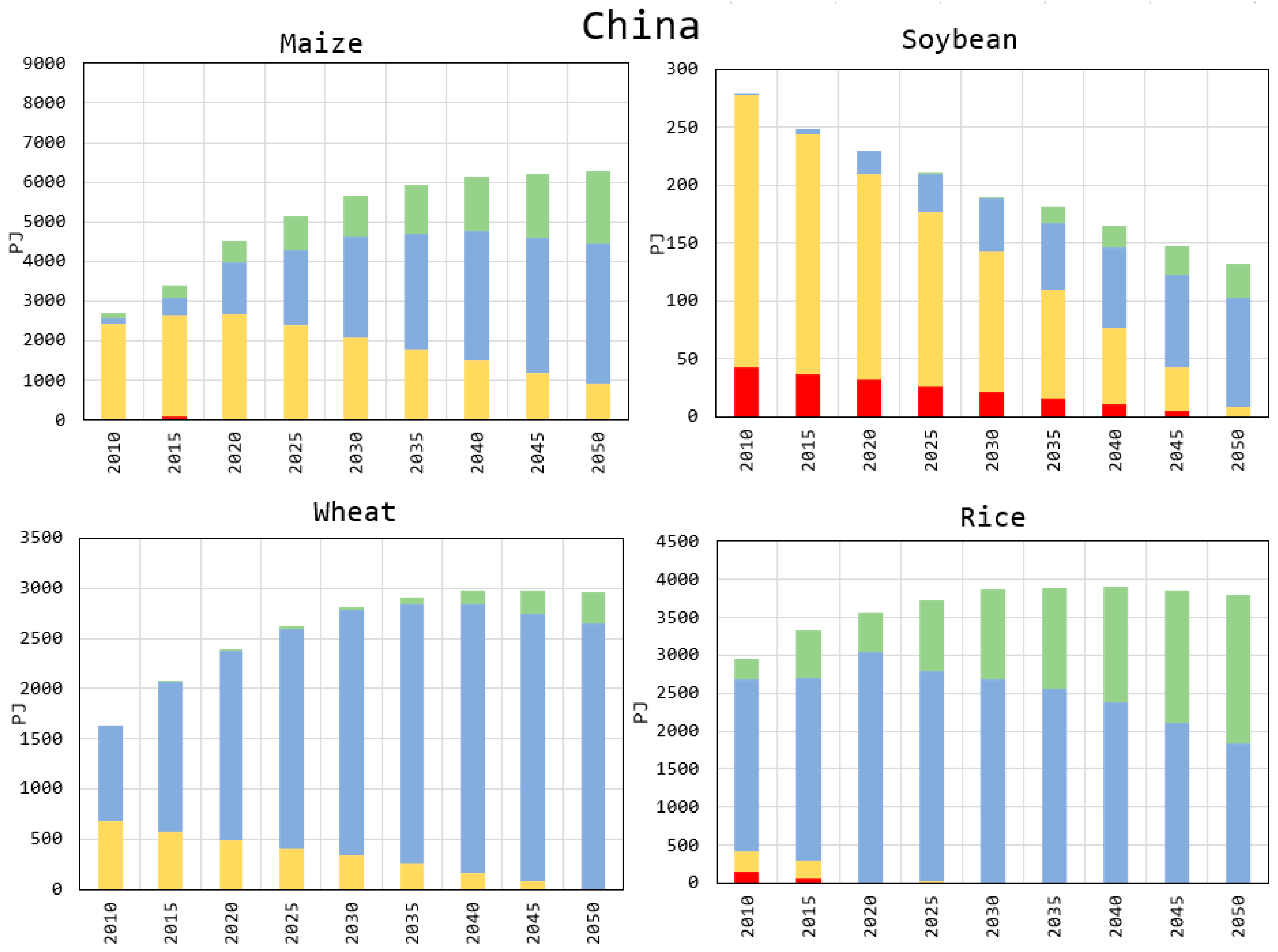
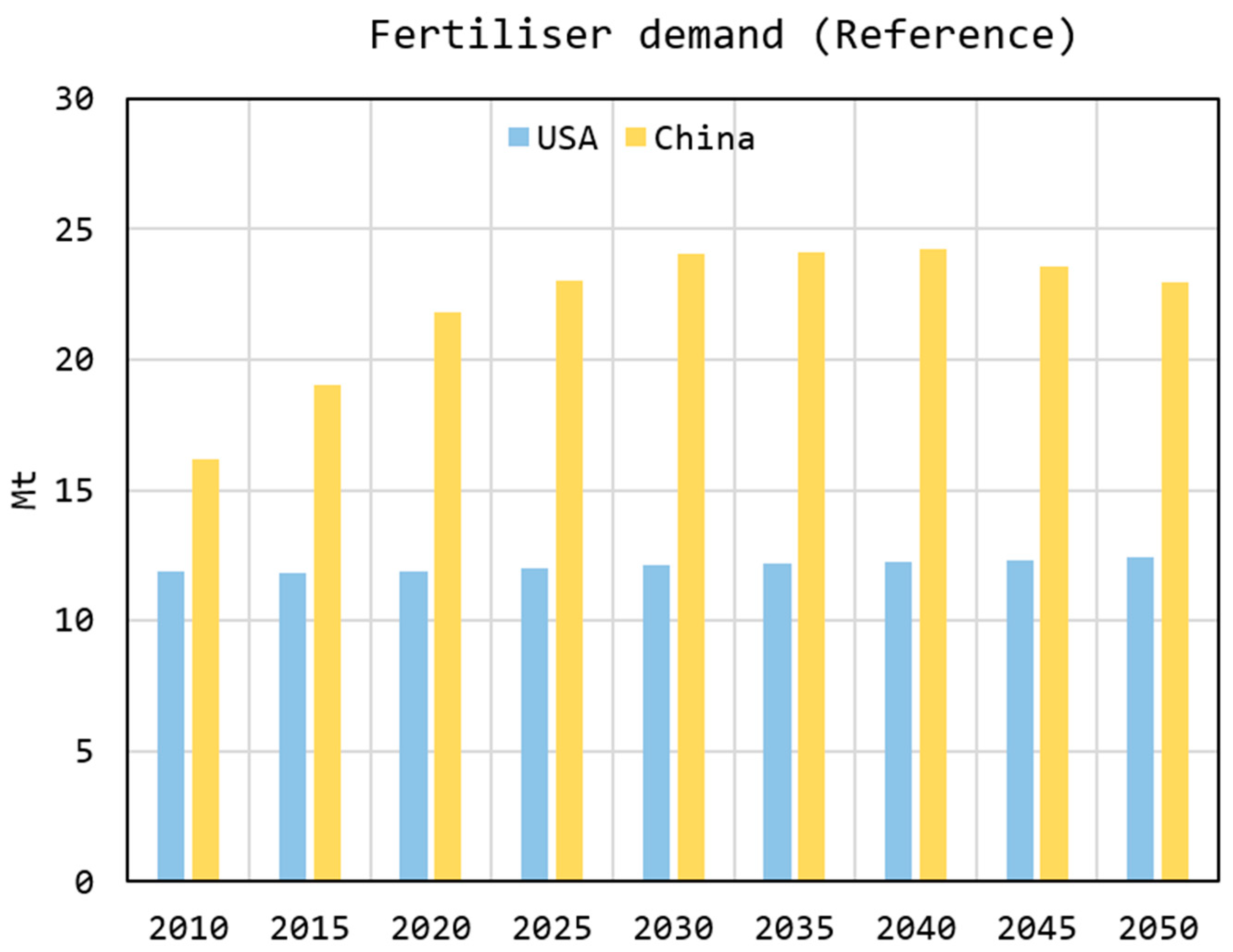

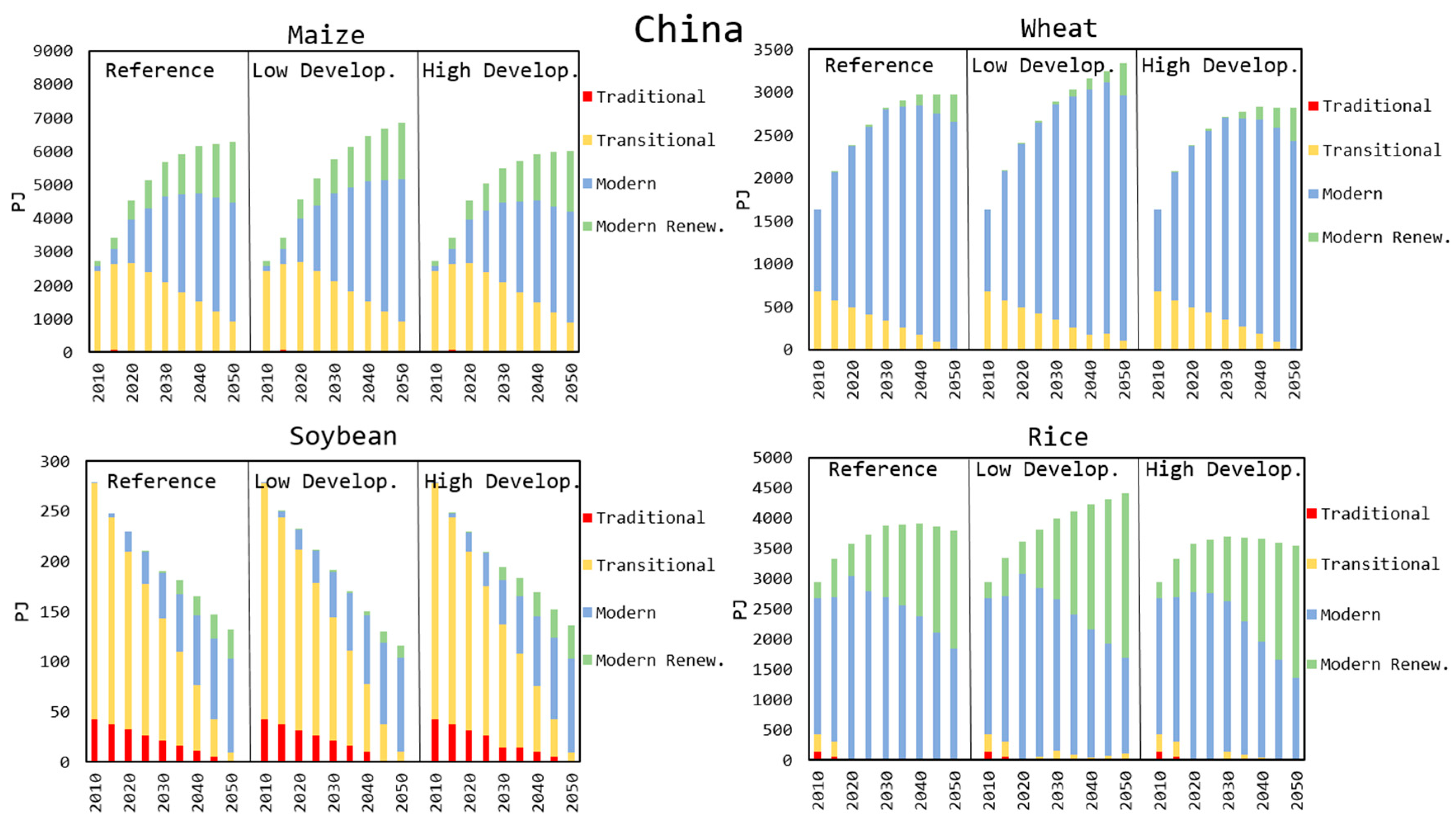
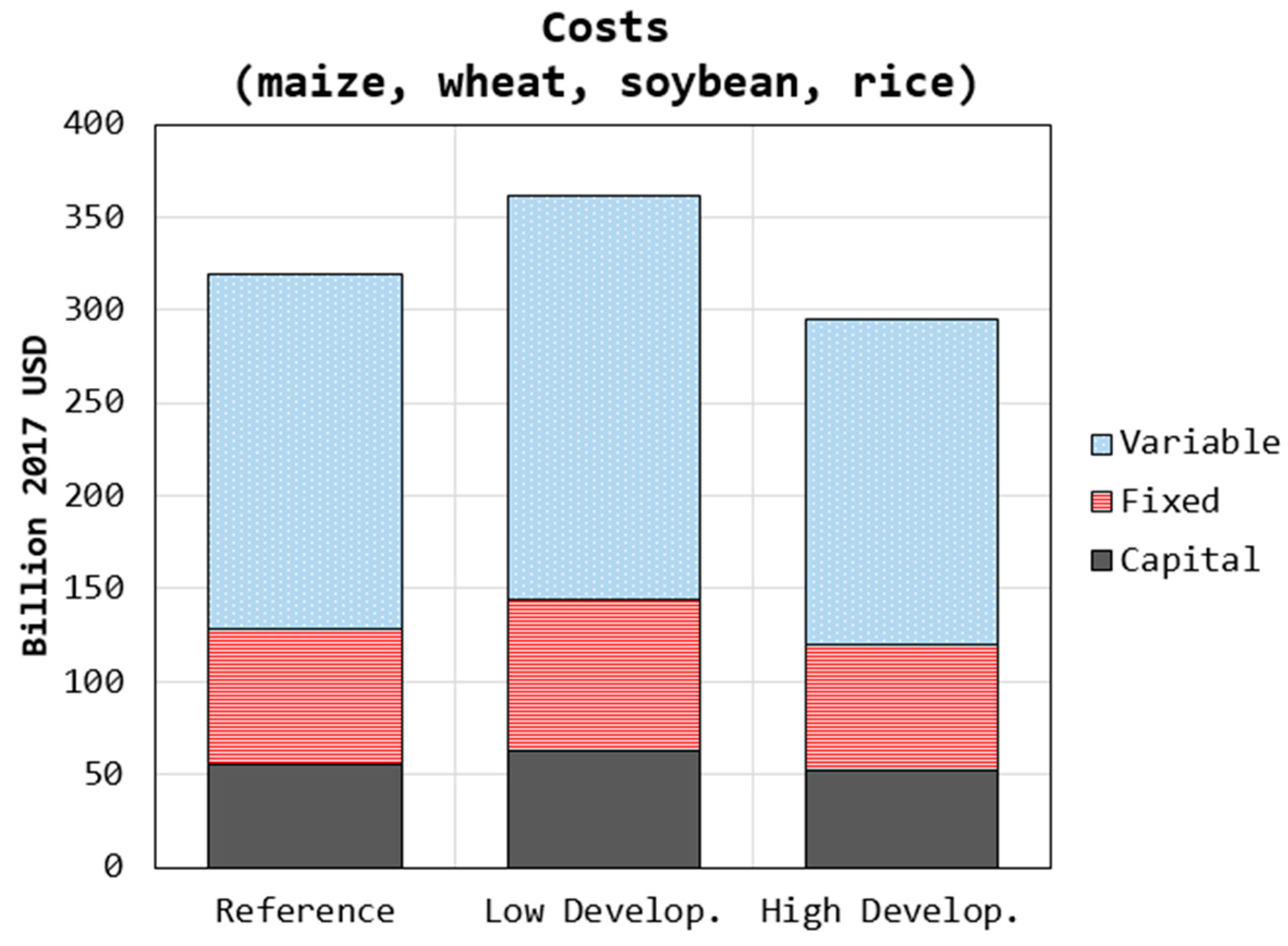
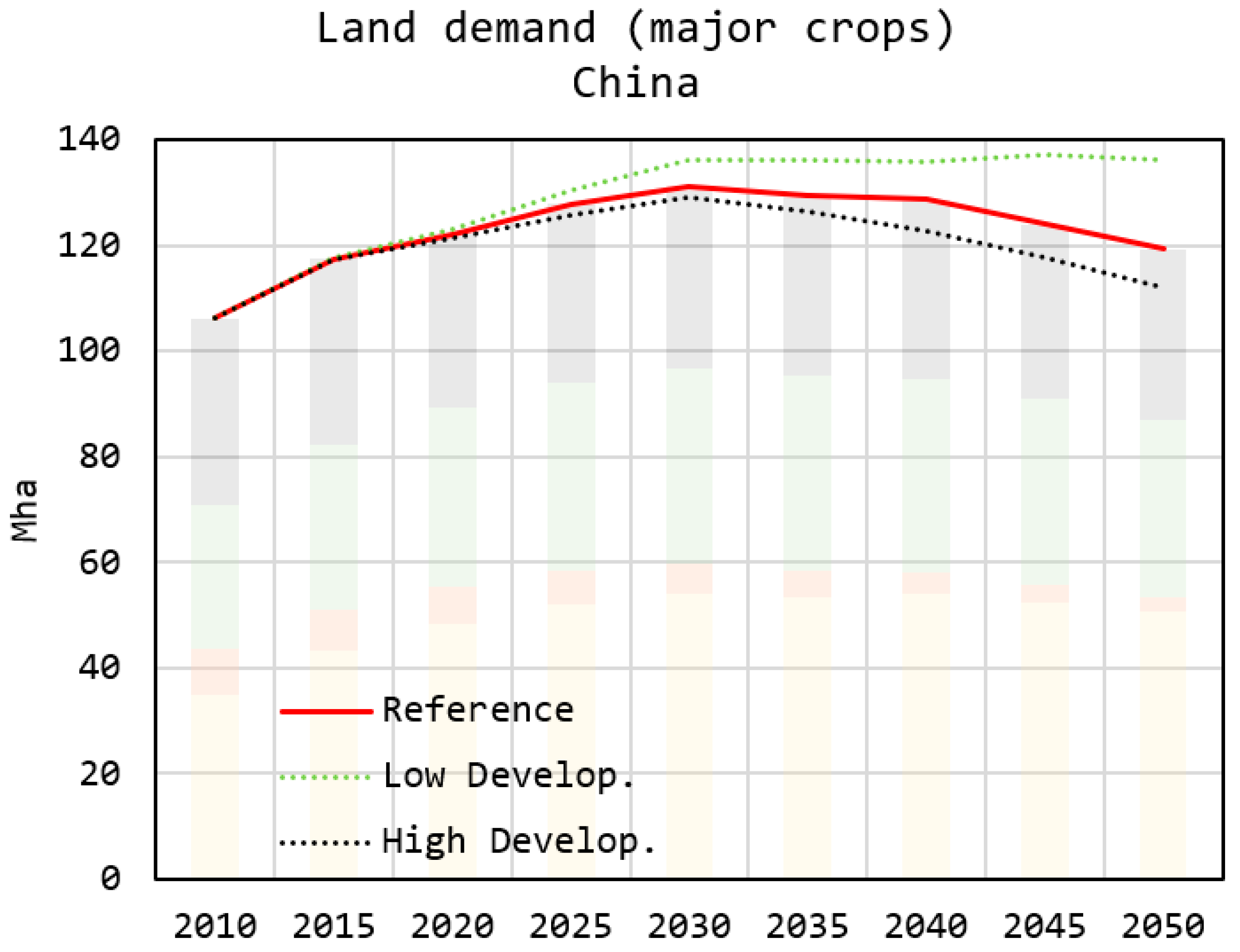
| Crop | Global (Mt) | USA (Mt) | Relative Importance by Mt Produced USA (Rank) | China (Mt) | Relative Importance by Mt Produced China (Rank) |
|---|---|---|---|---|---|
| Sugar cane | 1891 | 30 | 5th | 123 | 5th |
| Maize | 1060 | 385 | 1st | 232 | 1st |
| Wheat | 749 | 63 | 3rd | 132 | 4th |
| Rice, paddy | 741 | 10 | 8th | 211 | 2nd |
| Potatoes | 377 | 20 | 6th | 99 | 6th |
| Soybeans | 334 | 117 | 2nd | 12 | 27th |
| Crop | kcal/kg | MJ/kg |
|---|---|---|
| Maize | 3650 | 15.27 |
| Soybean | 4460 | 18.66 |
| Wheat | 3390 | 14.18 |
| Rice | 3570 | 14.93 |
| Crop | Equation Form | R2 | M | C |
|---|---|---|---|---|
| Maize | Linear | 0.132 | 3.44 × 10−10 | 3.08 × 10−7 |
| Maize | Exponential | 0.891 | 9.77 × 10−5 | 1.03 × 10−6 |
| Maize | Semi-Log | 0.943 | 8.28 × 10−7 | −5.33 × 10−6 |
| Maize | Log-Log | 0.928 | 4.98 × 10−1 | −1.75 × 10−1 |
| Soybeans | Linear | 0.328 | −9.53 × 10−12 | 2.63 × 10−7 |
| Soybeans | Exponential | 0.301 | −4.36 × 10−5 | 2.67 × 10−7 |
| Soybeans | Semi-Log | 0.350 | −4.92 × 10−8 | 6.33 × 10−7 |
| Soybeans | Log-Log | 0.324 | −2.26 × 10−1 | −1.34 × 10−1 |
| Wheat | Linear | 0.838 | 7.75 × 10−11 | 7.14 × 10−7 |
| Wheat | Exponential | 0.826 | 7.18 × 10−5 | 7.66 × 10−7 |
| Wheat | Semi-Log | 0.895 | 4.00 × 10−7 | −2.29 × 10−6 |
| Wheat | Log-Log | 0.885 | 3.71 × 10−1 | −1.69 × 10−1 |
| Rice, paddy | Linear | 0.718 | 6.98 × 10−11 | 1.71 × 10−6 |
| Rice, paddy | Exponential | 0.698 | 3.44 × 10−5 | 1.74 × 10−6 |
| Rice, paddy | Semi-Log | 0.763 | 3.59 × 10−7 | −9.89 × 10−7 |
| Rice, paddy | Log-Log | 0.746 | 1.77 × 10−1 | −1.46 × 10−1 |
| Crop | Mechanisation Level | Biomethane PJ/PJ | Biodiesel PJ/PJ | Diesel PJ/PJ | Electricity GWh/PJ | Gas PJ/PJ | Gasoline PJ/PJ | Coal PJ/PJ | Draught hrs/GJ | Labour hrs/GJ |
|---|---|---|---|---|---|---|---|---|---|---|
| Maize | Traditional | 0 | 0 | 0 | 0 | 0 | 0 | 0.002 | 0.9 | 150.0 |
| Maize | Transitional | 0 | 0 | 0.023 | 0.097 | 0 | 0.001 | 0.015 | 0.1 | 16.3 |
| Maize | Modern Fossil | 0 | 0 | 0.027 | 0.110 | 0.010 | 0.007 | 0.066 | 0 | 0.5 |
| Maize | Modern Renewable | 0.004 | 0.007 | 0.012 | 0.120 | 0 | 0 | 0 | 0 | 0 |
| Wheat | Traditional | 0 | 0 | 0.105 | 0 | 0 | 0 | 0 | 1.1 | 123.5 |
| Wheat | Transitional | 0 | 0 | 0.198 | 0.366 | 0.003 | 0.005 | 0.129 | 0.1 | 16.3 |
| Wheat | Modern Fossil | 0 | 0 | 0.262 | 0.636 | 0.102 | 0.073 | 0.648 | 0 | 6.6 |
| Wheat | Modern Renewable | 0.031 | 0.062 | 0.104 | 0.727 | 0 | 0 | 0 | 0 | 0 |
| Soybean | Traditional | 0 | 0 | 0.061 | 0 | 0 | 0 | 0 | 1.7 | 237.8 |
| Soybean | Transitional | 0 | 0 | 0.063 | 0.103 | 0.001 | 0 | 0.041 | 0.4 | 55.1 |
| Soybean | Modern Fossil | 0 | 0 | 0.063 | 0.195 | 0.024 | 0.001 | 0.155 | 0 | 6.6 |
| Soybean | Modern Renewable | 0.010 | 0.020 | 0.033 | 0.278 | 0 | 0.020 | 0 | 0 | 0 |
| Rice | Traditional | 0 | 0 | 0 | 0 | 0 | 0 | 0 | 44.9 | 286.2 |
| Rice | Transitional | 0 | 0 | 0.133 | 1.272 | 0.002 | 0.003 | 0.087 | 20.6 | 131.6 |
| Rice | Modern Fossil | 0 | 0 | 0.266 | 2.300 | 0.104 | 0.074 | 0.657 | 0 | 9.2 |
| Rice | Modern Renewable | 0.030 | 0.060 | 0.100 | 2.600 | 0 | 0 | 0 | 0 | 0 |
| Technological | Maize Yield | Soybean Yield | Wheat Yield | Rice Yield |
|---|---|---|---|---|
| Level | (kg ha−1) | (kg ha−1) | (kg ha−1) | (kg ha−1) |
| Traditional | 1200 | 1000 | 1750 | 1750 |
| Transitional | 5000 | 1900 | 3000 | 3000 |
| Modern | 8500 | 2500 | 6000 | 7000 |
| Modern Renewable | 11,000 | 3500 | 9000 | 9000 |
| Mechanisation | Maize | Soybean | Wheat | Rice |
|---|---|---|---|---|
| Level | (kg ha−1) | |||
| Traditional | 139 | 42 | 82 | 32 |
| Transitional | 215 | 51 | 92 | 105 |
| Modern | 270 | 57 | 106 | 181 |
| Modern Ren. | 245 | 45 | 93 | 155 |
| China (kt PJ−1) | |||||
|---|---|---|---|---|---|
| N2O Maize | N2O Wheat | N2O Soybean | N2O Rice | CH4 Rice | |
| Traditional | 0.065 | 0.007 | 0.021 | 0.012 | 4.725 |
| Transitional | 0.027 | 0.007 | 0.024 | 0.027 | 2.756 |
| Modern | 0.021 | 0.006 | 0.020 | 0.026 | 1.181 |
| Modern Ren. | 0.016 | 0.006 | 0.015 | 0.020 | 0.919 |
| Crop | Maximum Capacity Addition for China (PJ y−1) | |||
| Traditional | Transitional | Modern | Modern Renew. | |
| Maize | 30.0 | 90.0 | 200.0 | 40.0 |
| Soybean | 15.0 | 20.0 | 140.0 | 50.0 |
| Wheat | - | 0 | 3.0 | 1.0 |
| Rice | 4.0 | 30.0 | 200.0 | 80.0 |
| Capital Costs (MUSD/PJ y−1) | ||||
| Traditional | Transitional | Modern | Modern Renew. | |
| Maize | 1.6 | 2.2 | 2.8 | 2.9 |
| Soybean | 2.8 | 6.3 | 6.6 | 6.9 |
| Wheat | 3.8 | 5.3 | 6.3 | 8 |
| Rice | 1.8 | 3.7 | 4.8 | 5.1 |
| Fixed Costs (MUSD/PJ y−1) | ||||
| Traditional | Transitional | Modern | Modern Renew. | |
| Maize | 1.3 | 1.1 | 1 | 0.8 |
| Soybean | 1.2 | 2 | 2.1 | 1.8 |
| Wheat | 2.1 | 2.1 | 2 | 1.7 |
| Rice | 0.9 | 1.5 | 1.9 | 1.6 |
| Variable Costs (MUSD/PJ y−1) | ||||
| Traditional | Transitional | Modern | Modern Renew. | |
| Maize | 1.4 | 2.2 | 3.1 | 2.5 |
| Soybean | 1.5 | 4.2 | 4.4 | 3.8 |
| Wheat | 1.3 | 2.7 | 3.6 | 3 |
| Rice | 4.8 | 5.4 | 5.8 | 4.9 |
| Ag & LU Key Inputs | Ag & LU Key Outputs |
|---|---|
| Techno-economic characterisation for each agriculture crop | Agricultural mechanisation detail outputs |
| • Input by energy source (PJ/PJ) | • Fuel demand by source (PJ) |
| • Conversion efficiency (%) | • Agricultural commodity production (PJ) |
| • Agrochemical input (N fertiliser) (kt PJ−1) | • Aggregated CAPEX and OPEX of new installed technologies (mechanisation) (USD) |
| • Yields (Mha PJ−1) | • Aggregated demand of agrochemicals (kt) |
| • Emissions (KtCO2eq PJ−1) | • Land use demand by agricultural crop (Mha) |
| • Unit capital and operational cost (USD PJ−1) | • Aggregated Emissions due to direct energy use, fertilisers and Land use change (KtCO2eq) |
| Existing stock for the base year including their retirement pro le (PJ y−1) | |
| Policy framework and fiscal regimes | |
| Macro-economic drivers’ projections (e.g., GDPcap, population, urbanisation) |
| Crop | Installed Capacity PJ y−1 (GW) | Annual Avg. Yield [6] (kg ha−1) | Share of Production (%) | ||||||
|---|---|---|---|---|---|---|---|---|---|
| Traditional | Transitional | Modern | Modern Ren. | Traditional | Transitional | Modern | Modern Ren. | ||
| Maize | 27.1 (0.9) | 2395.5 (76.0) | 153.3 (4.9) | 135.6 (4.3) | 5460.0 | 1.0% | 88.3% | 5.7% | 5.0% |
| Soybean | 42.3 (1.3) | 236.5 (7.5) | 2.8 (0.1) | 0.0 (0.0) | 1771.0 | 15.0% | 84.0% | 1.0% | 0.0% |
| Wheat | 0.0 (0.0) | 681.5 (21.6) | 952.1 (30.2) | 0.0 (0.0) | 4748.0 | 0.0% | 41.7% | 58.3% | 0.0% |
| Rice | 147.3 (4.7) | 272.2 (8.6) | 2261.4 (71.7) | 265.2 (8.4) | 6548.0 | 5.0% | 9.2% | 76.8% | 9.0% |
| Scenario | Population/ Food Demand Growth by 2050 | Fossil Fuel Price | Carbon Price | Modern Mechanisation Costs | Yields (Annual Growth) |
|---|---|---|---|---|---|
| Reference | SSP2 metrics [71] | IEA [72]/EIA [73] reference scenario | EMF27 [74] reference scenario | No changes | +0.8% |
| Low Development (high population growth/food demand) | SSP3 metrics +20% | −20% | No carbon tax | +20% | +0.5% |
| High Development (low population growth/food demand) | SSP1 metrics −20% | +20% | High price EMF 27 [74] 10 times larger tax—CH4 25 times larger tax—N2O | −20% | +1.3% |
| Fuel Use (PJ y−1) | |||||||||
| Energy Commodity | 2010 | 2015 | 2020 | 2025 | 2030 | 2035 | 2040 | 2045 | 2050 |
| Electricity | 141 | 171 | 195 | 209 | 221 | 225 | 229 | 228 | 227 |
| Diesel | 206 | 243 | 288 | 296 | 309 | 310 | 308 | 297 | 285 |
| Natural Gas | 1 | 1 | 2 | 2 | 3 | 3 | 4 | 4 | 5 |
| Gasoline | 29 | 43 | 49 | 52 | 55 | 56 | 57 | 57 | 56 |
| Coal | 145 | 211 | 227 | 227 | 223 | 211 | 197 | 179 | 161 |
| Biogas | 1 | 3 | 2 | 4 | 5 | 6 | 7 | 8 | 9 |
| Biodiesel | 2 | 5 | 4 | 8 | 9 | 11 | 13 | 15 | 18 |
| Draught [109 hrs] | 17.22 | 11.17 | 6.33 | 3.42 | 0.57 | 0.43 | 0.36 | 0.28 | 0.50 |
| Labour [109 hrs] | 182.65 | 164.80 | 110.20 | 108.16 | 97.45 | 85.71 | 78.06 | 66.33 | 56.63 |
| Total Emissions (Mt y−1) ¥ | |||||||||
| GHG (CO2eq) | 2010 | 2015 | 2020 | 2025 | 2030 | 2035 | 2040 | 2045 | 2050 |
| CO2 | 31 | 41 | 46 | 47 | 48 | 47 | 46 | 43 | 41 |
| CH4 | 109 | 109 | 102 | 105 | 107 | 106 | 105 | 102 | 100 |
| N2O | 49 | 57 | 66 | 70 | 73 | 73 | 74 | 73 | 71 |
| Reference | Low Development | High Development | |||||||
|---|---|---|---|---|---|---|---|---|---|
| Fuel (PJ) | 2010 | 2030 | 2050 | 2010 | 2030 | 2050 | 2010 | 2030 | 2050 |
| Electricity | 141 | 221 | 227 | 141 | 225 | 262 | 141 | 207 | 215 |
| Diesel | 206 | 309 | 285 | 206 | 310 | 308 | 206 | 294 | 255 |
| Natural Gas | 1 | 3 | 5 | 1 | 2 | 3 | 1 | 3 | 6 |
| Gasoline | 29 | 55 | 56 | 29 | 56 | 65 | 29 | 52 | 53 |
| Coal | 145 | 223 | 161 | 145 | 277 | 321 | 145 | 165 | 118 |
| Biogas | 1 | 5 | 9 | 1 | 5 | 12 | 1 | 4 | 10 |
| Biodiesel | 2 | 9 | 18 | 2 | 11 | 24 | 2 | 9 | 20 |
| Draught [109 h] | 17.22 | 0.57 | 0.50 | 17.22 | 5.48 | 3.20 | 17.22 | 5.05 | 0.28 |
| Labour [109 h] | 182.65 | 97.45 | 56.63 | 182.65 | 120.41 | 70.92 | 182.65 | 114.80 | 47.96 |
| Emissions (Mt CO2eq) | 2010 | 2030 | 2050 | 2010 | 2030 | 2050 | 2010 | 2020 | 2050 |
| CO2 | 31 | 48 | 41 | 31 | 53 | 58 | 31 | 41 | 34 |
| CH4 | 109 | 107 | 100 | 109 | 116 | 117 | 109 | 109 | 90 |
| N2O | 49 | 73 | 71 | 49 | 74 | 79 | 49 | 70 | 67 |
| Fertiliser Demand (Mt) | |||||||||
|---|---|---|---|---|---|---|---|---|---|
| Reference | Low Development | High Development | |||||||
| 2010 | 2030 | 2050 | 2010 | 2030 | 2050 | 2010 | 2030 | 2050 | |
| China | 16 | 24 | 23 | 16 | 25 | 26 | 16 | 23 | 21 |
Publisher’s Note: MDPI stays neutral with regard to jurisdictional claims in published maps and institutional affiliations. |
© 2020 by the authors. Licensee MDPI, Basel, Switzerland. This article is an open access article distributed under the terms and conditions of the Creative Commons Attribution (CC BY) license (http://creativecommons.org/licenses/by/4.0/).
Share and Cite
García Kerdan, I.; Giarola, S.; Skinner, E.; Tuleu, M.; Hawkes, A. Modelling Future Agricultural Mechanisation of Major Crops in China: An Assessment of Energy Demand, Land Use and Emissions. Energies 2020, 13, 6636. https://doi.org/10.3390/en13246636
García Kerdan I, Giarola S, Skinner E, Tuleu M, Hawkes A. Modelling Future Agricultural Mechanisation of Major Crops in China: An Assessment of Energy Demand, Land Use and Emissions. Energies. 2020; 13(24):6636. https://doi.org/10.3390/en13246636
Chicago/Turabian StyleGarcía Kerdan, Iván, Sara Giarola, Ellis Skinner, Marin Tuleu, and Adam Hawkes. 2020. "Modelling Future Agricultural Mechanisation of Major Crops in China: An Assessment of Energy Demand, Land Use and Emissions" Energies 13, no. 24: 6636. https://doi.org/10.3390/en13246636
APA StyleGarcía Kerdan, I., Giarola, S., Skinner, E., Tuleu, M., & Hawkes, A. (2020). Modelling Future Agricultural Mechanisation of Major Crops in China: An Assessment of Energy Demand, Land Use and Emissions. Energies, 13(24), 6636. https://doi.org/10.3390/en13246636





